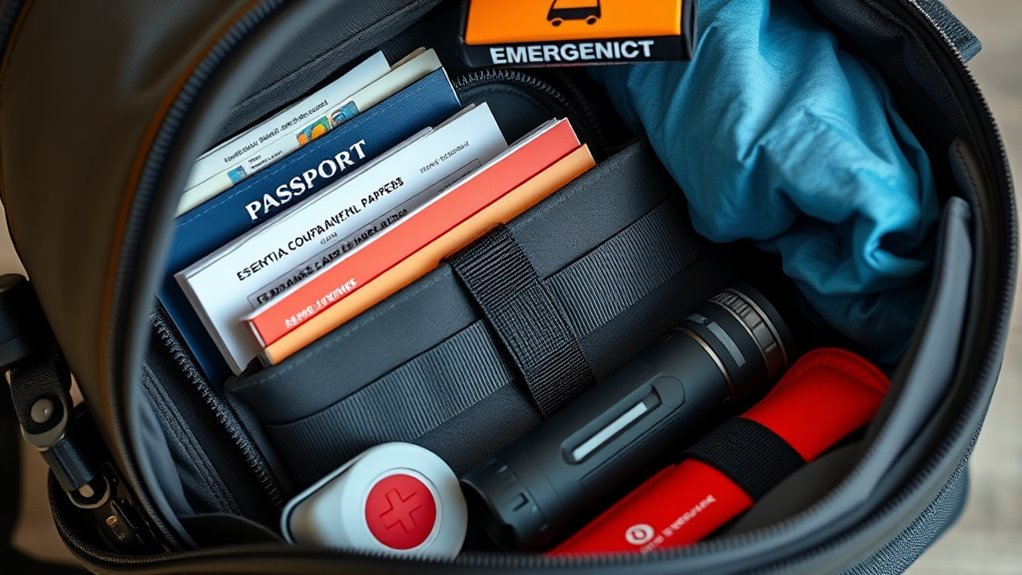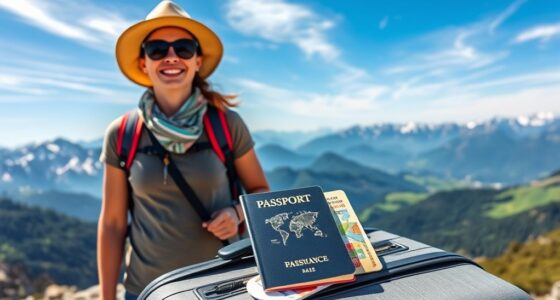To create a travel emergency kit for crises, start by evaluating your destination’s risks, local customs, and environment. Pack essential first aid, personal medications, and important documents protected in waterproof, secure storage. Include survival gear like water filters, non-perishable food, and weather-appropriate clothing. Organize everything for easy access and regularly check expiration dates. Tailoring your kit to your specific trip and environment boosts your safety—continue to explore how to optimize your preparedness effectively.
Key Takeaways
- Research local risks, customs, and emergency contacts to tailor your kit for specific travel environments and potential crises.
- Include essential supplies such as first aid items, medications, non-perishable food, water purification tools, and multi-tools.
- Secure important documents with waterproof holders and create digital backups for quick access during emergencies.
- Organize your kit with clearly labeled sections, prioritizing frequently used items for rapid deployment.
- Regularly review and update supplies, check expiration dates, and adapt contents to changing conditions and seasonal needs.
Assessing Your Travel Destination and Potential Risks

Before packing your emergency travel kit, conducting thorough research on your destination is essential. You need to understand the cultural considerations that could influence your response to emergencies, such as local customs or language barriers. Knowing these helps you communicate effectively and avoid misunderstandings. Additionally, identify the local emergency contacts—such as police stations, hospitals, and embassy numbers—so you’re prepared if trouble arises. Research the area’s safety concerns and common risks, whether it’s natural disasters, political unrest, or health threats. This awareness helps you tailor your kit and emergency plan accordingly. Understanding the environment and establishing clear communication channels, including essential safety information, will be crucial in responding swiftly and confidently in any crisis. Being familiar with local vehicle regulations and infrastructure can also be valuable if transportation issues occur during an emergency. Incorporating knowledge about local emergency response protocols can further enhance your preparedness and response effectiveness. Familiarity with natural disaster preparedness specific to your destination can help you act quickly and appropriately if such events occur. Additionally, staying informed about creative storytelling for branding and how it can be used to communicate during crises may aid in managing perceptions and disseminating important information effectively.
Selecting Essential First Aid Supplies

How do you determine which first aid supplies are truly essential for your travel kit? Start by considering common injuries and health issues you might face. Your first aid kit should include basic emergency supplies like adhesive bandages, antiseptic wipes, and gauze pads to treat cuts and scrapes. Include pain relievers, allergy medications, and any personal prescriptions. Don’t forget scissors, tweezers, and medical tape for more complex needs. Think about the environment—if you’ll be outdoors, add insect repellent and sunburn relief. Keep your supplies organized and easily accessible. Selecting the right items ensures you’re prepared for minor injuries or emergencies without overloading your kit. Tailor your first aid kit to your destination, activities, and personal health requirements for maximum effectiveness. Incorporate essential items based on the specific risks associated with your travel environment to ensure comprehensive coverage. Additionally, understanding survival gear maintenance and proper usage can help keep your supplies functional and ready when needed.
Packing Important Documents Securely

To keep your important documents safe during emergencies, use waterproof document holders to protect them from water damage. Consider digital backups stored securely online or on encrypted devices for easy access if paper copies are lost. Also, choose discreet, secure locations to store your physical documents, ensuring they’re both accessible and protected. Utilizing home organization systems can help keep your documents orderly and easily retrievable in times of crisis. Additionally, implementing document labeling techniques can facilitate quick identification and access when needed. Incorporating secure storage practices that prevent unauthorized access can further safeguard sensitive information during emergencies. Furthermore, understanding electric bike capabilities can be beneficial if you need to rely on alternative transportation methods during a crisis. Being aware of emergency communication methods can also ensure you stay connected and informed throughout the situation.
Waterproof Document Holders
A waterproof document holder is crucial for keeping your important papers safe and dry during emergencies. When you’re out in unpredictable conditions, these waterproof document holders protect essential items like IDs, passports, insurance papers, and emergency contacts from water damage. Designed as part of your outdoor adventure gear, they are durable, lightweight, and easy to carry. You can stash them in your backpack or glove compartment for quick access. Look for holders with secure sealing mechanisms, such as zip-lock or roll-top closures, to ensure no water seeps in. Using a waterproof document holder means you won’t have to worry about losing critical documents if unexpected rain, floods, or spills occur. It’s a simple but vital step in creating a reliable travel emergency kit. Proper storage solutions can help prevent damage and keep your vital documents accessible in any crisis, especially during spiritual guidance moments where clarity is essential. Incorporating waterproofing techniques, such as selecting the right materials and seals, further enhances the protection of your documents against water exposure. Additionally, choosing high-quality waterproof materials can significantly extend the lifespan and reliability of your document holders, and understanding the benefits of waterproofing can help you make informed choices.
Digital Backup Options
While waterproof document holders protect your physical papers from water damage, digital backups offer an extra layer of security for your important information. Using cloud storage ensures your documents are accessible from anywhere, even if your devices are lost or damaged. To maximize digital security, consider these steps:
- Use strong, unique passwords for your accounts.
- Enable two-factor authentication for added protection.
- Regularly update your software and security settings.
- Encrypt sensitive files before uploading them to the cloud. Secure data storage is essential for safeguarding your files against cyber threats and physical loss. Additionally, understanding how market volatility affects investments can help you choose the right strategies for protecting your assets during turbulent times. Implementing risk assessment practices can help identify vulnerabilities in your digital backups and improve your overall preparedness. Digital backups are essential for quick access and peace of mind during emergencies, ensuring your critical information remains safe and recoverable wherever you are.
Secure Storage Locations
Choosing the right storage locations for your important documents is crucial to keep them safe during travel. You should consider hidden storage options that are discreet yet easily accessible in emergencies. Secure containers, like waterproof and lockable cases, provide an extra layer of protection against theft, water damage, or loss. Avoid storing critical documents in obvious places, such as your wallet or easily reachable pockets. Instead, select a small, concealed compartment in your luggage or a hidden storage pocket on your clothing. These locations help ensure your documents stay safe even if your bag is stolen or compromised. Remember, the goal is to keep essential papers like passports, IDs, and insurance cards protected and accessible when needed most. Incorporating secure storage methods ideas can help you organize and safeguard your documents more effectively, especially by considering navigation and mapping techniques to remember discreet locations. Additionally, understanding privacy and cookie usage can inform how you safeguard digital copies of your documents from online threats.
Assembling Basic Survival Gear

When assembling your basic survival gear, focus on selecting essential items that can sustain you in emergency situations. Your gear should include versatile tools for shelter options and food preservation. Consider these four critical items:
Focus on lightweight, durable essentials like shelter, water purification, non-perishable food, and multi-tools for emergencies.
- Emergency tent or tarp – provides quick shelter, protecting you from the elements.
- Portable water filter or purification tablets – guarantee access to safe drinking water.
- Non-perishable food supplies – long-lasting, lightweight, and calorie-dense for sustenance.
- Multi-tool or knife – helps with shelter building, food prep, and other tasks. Incorporating vehicle modifications such as reinforced bumpers or additional storage can also be beneficial for larger-scale emergency preparedness.
These items help you adapt to different environments and extend your ability to survive. Prioritize lightweight, durable gear that supports shelter options and food preservation, so you’re prepared for unexpected crises. Incorporating AI-powered tools can assist in planning and optimizing your emergency kit for various scenarios.
Including Personal Medications and Health Items

Make sure to include an essential medication stockpile tailored to your needs, so you’re prepared for unexpected delays. Don’t forget health and wellness supplies like bandages, pain relievers, and personal hygiene items. Being proactive with these items can prevent minor issues from turning into major emergencies.
Essential Medication Stockpile
Having an essential medication stockpile is crucial for ensuring your health and safety during emergencies. You need to have enough supplies to last through disruptions, while also monitoring medication expiration dates to prevent ineffective or unsafe usage. Proper dosage management is critical to avoid under- or overdosing during stressful situations.
Consider these key items:
- Extra prescriptions of your personal medications, stored safely and checked regularly for expiration.
- A detailed list of medication dosages and schedules to maintain proper management.
- Basic health items like pain relievers, antihistamines, and electrolyte solutions.
- Backup supplies of essential health items tailored to your specific needs, ensuring you’re prepared for unforeseen issues.
Staying organized and vigilant about medication expiration and dosage management helps safeguard your health when it’s needed most.
Health and Wellness Supplies
Ensuring you have the right health and wellness supplies is essential for maintaining your well-being during emergencies. Pack personal medications like pain relievers, allergy remedies, and any prescribed drugs you might need. Don’t forget mental health items such as calming techniques, stress-relief tools, or a journal to help manage anxiety. Including fitness tools like resistance bands or a small yoga mat can help you stay active and boost your mood. Staying physically and mentally balanced is critical during stressful situations. Keep these supplies in an accessible, waterproof container to prevent damage. Regularly review and update your kit to ensure all items are current and functional. Properly prepared health and wellness supplies help you stay resilient and maintain a sense of control during crises.
Preparing for Communication and Navigation Needs

To stay connected and find your way during an emergency, you need to be prepared with reliable communication and navigation tools. Satellite communication devices ensure you can reach help even without cell service, while GPS navigation keeps you on track when landmarks are scarce. Consider these essential items:
Stay prepared with satellite devices, GPS tools, and backups to stay connected and navigate safely during emergencies.
- A satellite phone or device for emergency contact when cell networks fail
- Portable GPS units or smartphone apps for accurate navigation
- Extra batteries or portable chargers for continued device use
- Printed maps as a backup if electronic tools malfunction
Having these tools ready guarantees you can communicate effectively and navigate safely, no matter the situation. Proper preparation minimizes confusion and delays, giving you peace of mind during crises.
Incorporating Weather-Appropriate Clothing and Gear

When preparing your emergency travel kit, it’s just as important to contemplate the weather conditions you might face. Pack weather-resistant clothing to stay dry during rain or snow, and choose layers that can be added or removed as needed. Insulating gear, like thermal blankets or fleece, will help maintain body heat in cold environments. Consider a waterproof jacket, sturdy boots, and hats or gloves suited for extreme temperatures. Being prepared for sudden weather changes ensures you stay comfortable and protected. Remember, lightweight, versatile gear can make a significant difference in challenging conditions. Your goal is to stay dry, warm, and safe, so select clothing and gear designed for the climate you’re traveling through. Proper weather-appropriate clothing is essential to your overall safety.
Organizing Your Emergency Kit for Accessibility

Organizing your emergency kit so that everything is easily accessible can make a critical difference during an emergency. Use label organization to clearly identify each section, making it simple to find what you need quickly. Incorporate accessibility design by placing frequently used items at the front or top. Consider these key steps:
- Sort items by priority, such as first aid supplies, water, and food.
- Label compartments clearly—use large, readable tags for quick identification.
- Use stackable containers to maximize space and keep similar items together.
- Design for visibility, ensuring all essentials are easy to see and reach, even in low light.
Proper organization minimizes panic and delays, helping you respond swiftly when time matters most.
Regularly Updating and Maintaining Your Kit

Keeping your emergency kit in top shape requires regular reviews and updates. Establish maintenance routines to check expiration dates on food, water, medications, and supplies. Replace items as needed to make certain everything remains functional and safe. Customizing your kit over time is vital; consider changing contents based on your travel destinations, season, or personal needs. For example, add extra warm clothing for winter trips or include specific medications. Keep a schedule to review your kit every few months, and after any use, to make sure it’s fully stocked and ready. Regular maintenance routines help prevent overlooked expired items and make sure your kit is tailored to your current circumstances. Staying proactive guarantees your kit will serve you effectively during emergencies.
Frequently Asked Questions
How Do I Customize My Kit for Different Climates and Terrains?
To customize your kit for different climates and terrains, include climate-specific gear like sun protection or cold-weather essentials, and terrain-adapted supplies such as sturdy footwear for rough trails or waterproof gear for rain. Adjust your first aid kit with items suited for potential injuries in each environment, and pack navigation tools appropriate for the terrain. Regularly review and update your kit to make certain you’re prepared for any climate or terrain challenges.
What Are Cost-Effective Ways to Build a Comprehensive Emergency Kit?
To build a cost-effective emergency kit, you should focus on budget shopping for essential supplies and look for multi-use items that serve multiple purposes. You can find affordable gear at discount stores or online sales, and choose versatile tools like a Swiss Army knife, or a multi-purpose flashlight. Prioritize quality over quantity, and reuse or repurpose items whenever possible to stretch your budget further.
How Can I Ensure My Kit Remains Lightweight but Complete?
Sure, because lugging around a suitcase-sized kit screams adventure, right? To keep it lightweight yet complete, focus on compact storage and only pack essential items—think multi-use tools, mini first aid kits, and versatile snacks. Prioritize quality over quantity, and choose lightweight materials. Regularly review and update your kit so it stays lean and relevant, making sure you’re prepared without turning travel into a weightlifting contest.
What Are Common Mistakes to Avoid When Assembling an Emergency Kit?
To avoid common pitfalls and kit oversights, double-check that you include essential items like water, first aid supplies, and a flashlight. Don’t forget to customize your kit based on your destination and activities, and avoid overpacking unnecessary items that add weight. Regularly review and update your kit, ensuring batteries are fresh and supplies are intact. Staying mindful of these mistakes helps you stay prepared and ready for emergencies.
How Often Should I Conduct Emergency Drills With My Prepared Kit?
You should conduct emergency drills with your kit at least twice a year to make certain you’re familiar with its contents and functionality. Regular drill frequency helps you identify any items that may need replacement or updating. During each kit review, check expiration dates, inventory levels, and overall readiness. This practice keeps you prepared, confident, and quick to respond in a crisis, ultimately increasing your safety and peace of mind.
Conclusion
Your emergency kit is your lifeline in the chaos of unforeseen crises, a trusty compass guiding you through stormy waters. By staying prepared and keeping your gear well-organized, you turn the unpredictable into manageable waves. Think of it as your safety net—ready to catch you when the skies turn dark. With each item in place, you’re not just packing supplies; you’re weaving a shield of confidence around your journey, ready to face anything that comes your way.









